A tree farm is a place where trees are grown, nurtured, and harvested for various purposes. These farms play a crucial role in providing us with timber, wood products, and even contribute to environmental conservation. The concept of a tree farm revolves around sustainable practices, ensuring that the delicate balance between human needs and ecological health is maintained.
In a tree farm, young trees are often planted with care and attention to detail. These saplings are like the starting point of a life cycle that will span several years. Farmers and foresters invest time and effort to choose the right species of trees that are well-suited to the local climate and soil conditions. This thoughtful selection process ensures a higher chance of success in the growth and development of the trees.
As the trees grow, they undergo various stages of maturity, requiring periodic care and maintenance. This may involve pruning, thinning, or protecting the trees from pests and diseases. The goal is not only to maximize the yield of wood products but also to promote the overall health and vitality of the forest ecosystem.
Tree farms contribute significantly to the economy by providing a sustainable source of timber and wood products. These products, ranging from lumber for construction to paper for everyday use, have a wide array of applications in our daily lives. The careful management of tree farms ensures that we can enjoy these resources without depleting the natural environment.
Beyond economic benefits, tree farms also play a crucial role in environmental conservation. Trees act as carbon sinks, absorbing carbon dioxide from the atmosphere and releasing oxygen during photosynthesis. By maintaining and expanding tree farms, we contribute to mitigating the impacts of climate change and preserving biodiversity.
One notable aspect of tree farming is the concept of reforestation. After a harvest, new trees are often planted to replace the ones that were cut down. This sustainable practice ensures that the forest remains productive and continues to fulfill its ecological functions. Reforestation efforts also help combat deforestation, a global challenge that threatens the health of our planet.
Visiting a tree farm can be a serene and educational experience. Walking through rows of towering trees, one can appreciate the intricate beauty of nature and gain a deeper understanding of the importance of responsible forestry.
Some tree farms even offer educational programs to schools and communities, allowing people to learn about the life cycle of trees, sustainable forestry practices, and the positive impact of tree farming on the environment.
The commitment to sustainable forestry is a defining feature of modern tree farms. This involves careful planning and monitoring to ensure that the rate of tree harvesting is balanced with the rate of tree growth. Sustainable practices also include protecting wildlife habitats within the tree farm, promoting biodiversity, and minimizing the use of harmful chemicals.
Tree farms contribute to the overall health of the planet by sequestering carbon, preventing soil erosion, and providing habitats for various species. They are an integral part of the global effort to address climate change and promote environmental stewardship. The symbiotic relationship between humans and trees on these farms demonstrates how responsible resource management can coexist with ecological preservation.
In addition to their ecological and economic importance, tree farms offer recreational opportunities. Many tree farms have trails and open spaces where people can enjoy activities such as hiking, bird-watching, or simply appreciating the natural beauty of the forest. These recreational aspects add another layer to the multifaceted role that tree farms play in our lives.
As we reflect on the significance of tree farms, it becomes clear that they represent a harmonious blend of human needs and environmental responsibility. The careful cultivation and harvesting of trees sustainably ensure that we can continue to benefit from wood products while safeguarding the health of our ecosystems. Tree farms stand as a testament to the idea that responsible resource management is not just an option but a necessity for the well-being of our planet and future generations.
Read Also: Where Do Honey Bees Nest
Benefits of Tree Farms

A tree farm offers a multitude of benefits, spanning ecological, economic, and societal dimensions.
1. Carbon Sequestration: Tree farms act as crucial carbon sinks, absorbing carbon dioxide during photosynthesis and helping mitigate the impacts of climate change. By storing carbon, they contribute to the reduction of greenhouse gas emissions.
2. Renewable Resource: Tree farms provide a sustainable and renewable source of wood and timber products. This ensures a continuous supply of materials for construction, furniture, and various other industries without depleting natural forests.
3. Biodiversity Support: Well-managed tree farms can support biodiversity by providing habitats for various species. This contributes to the overall health of ecosystems, fostering a diverse range of flora and fauna.
4. Soil Conservation: The roots of trees help anchor the soil, preventing erosion and maintaining its structure. This is crucial for preserving fertile soil and preventing runoff that can lead to water pollution.
5. Oxygen Production: Through the process of photosynthesis, trees release oxygen into the atmosphere. Tree farms, by cultivating a large number of trees, significantly contribute to the oxygen supply, vital for human and animal life.
6. Economic Contribution: Tree farms play a key role in the economy by providing jobs in forestry, logging, and related industries. The sustainable harvesting of trees ensures a continuous flow of income for those involved in the tree farming sector.
7. Recreational Opportunities: Many tree farms offer recreational spaces, providing people with opportunities for outdoor activities such as hiking, bird-watching, and nature appreciation. This contributes to the well-being of local communities.
8. Educational Value: Tree farms serve as educational resources, offering insights into sustainable forestry practices, reforestation efforts, and the importance of environmental conservation. Educational programs conducted on these farms enhance public awareness and understanding.
9. Climate Regulation: Trees contribute to the regulation of local and regional climates. They provide shade, reduce temperatures through evaporation, and create microclimates that benefit both ecosystems and nearby communities.
10. Water Management: Trees play a crucial role in water cycling. They absorb water through their roots and release it through transpiration, helping regulate water flow in watersheds and contributing to overall water management.
11. Aesthetic and Psychological Benefits: The presence of trees in a well-maintained farm enhances the visual appeal of landscapes and provides psychological benefits. Green spaces have been linked to reduced stress, improved mood, and enhanced overall mental well-being.
The benefits of a tree farm extend far beyond the production of wood products. They encompass environmental sustainability, economic stability, and the well-being of both natural ecosystems and human communities. The responsible management of tree farms is essential for ensuring these benefits are realized for current and future generations.
Read Also: How To Get Rid of Honey Bees Without Killing Them
How to Start a Tree Farm

Starting a tree farm requires careful planning and a commitment to sustainable practices. Here’s a simplified guide to help you get started:
1. Research and Planning:
Species Selection: Research tree species that are well-suited to your local climate and soil conditions. Consider the market demand for specific types of wood.
Market Analysis: Analyze the market demand for timber and wood products in your region. Identify potential customers and understand their needs.
Legal Requirements: Check local regulations and obtain any necessary permits for starting a tree farm. This may include zoning, environmental, and forestry permits.
2. Site Selection:
Soil and Climate: Choose a site with soil and climate conditions suitable for the selected tree species. Different trees thrive in different environments, so matching the species to the site is crucial.
Accessibility: Ensure the site is easily accessible for planting, maintenance, and harvesting operations.
3. Tree Planting:
Planting Methods: Determine the most appropriate planting method for your chosen species—whether it’s direct seeding, container planting, or transplanting seedlings.
Spacing: Follow recommended spacing guidelines to allow for proper growth and prevent overcrowding.
4. Care and Maintenance:
Watering: Provide adequate water during the establishment phase, especially for young trees.
Pruning and Thinning: Implement regular pruning and thinning practices to promote healthy growth and reduce competition among trees.
Pest and Disease Management: Monitor for pests and diseases, and implement appropriate control measures to protect your trees.
5. Sustainable Practices:
Harvesting Rotation: Develop a harvesting rotation plan to ensure a continuous and sustainable supply of wood. This involves harvesting mature trees while replanting new ones.
Biodiversity Conservation: Implement practices that support biodiversity within your tree farm. This can include leaving natural areas, maintaining wildlife corridors, and protecting water sources.
6. Record Keeping:
Inventory Management: Keep detailed records of the trees on your farm, including species, age, and growth rates.
Financial Records: Maintain financial records to track expenses, income, and profits.
7. Networking:
Industry Connections: Build relationships with local forestry organizations, suppliers, and potential buyers. Networking can provide valuable insights and support.
8. Educational and Recreational Opportunities:
Public Outreach: Consider offering educational programs or recreational activities on your tree farm. This not only enhances community engagement but also promotes awareness of sustainable forestry practices.
9. Adaptation and Continuous Improvement:
Adapt to Changes: Be adaptable and willing to adjust your strategies based on changing market conditions, environmental factors, and industry trends.
Seek Professional Advice: Consult with forestry experts or agricultural extension services for guidance on best practices and overcoming challenges.
Starting and managing a tree farm requires dedication, patience, and a long-term perspective. By implementing sustainable practices and staying informed about industry trends, you can establish a successful and environmentally responsible tree farm.
Read Also: The Impact of Waste to Art Business
